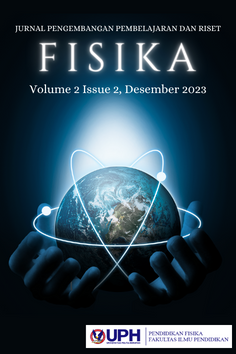PENERAPAN MODEL DIRECT INSTRUCTION UNTUK MENINGKATKAN PEMAHAMAN KONSEP SISWA PADA TOPIK KESEIMBANGAN STATIS SISTEM PARTIKEL BENDA TEGAR
Abstract
Concept understanding is important in physics learning because concept understanding is the basis for developing knowledge and solving problems, but the facts that occur in class XI IPA in one of the schools in Lampung, the pre-test results show that students' concept understanding is still lacking. The author applies direct instruction model as a solution to improve students' concept understanding. The writing of this paper aims to explain the application of the direct instruction model to improve students' concept understanding on the topic of static balance of the particle system of a rigid body with a qualitative descriptive method. The method used by the author is descriptive qualitative. The data sources used in preparing the paper are lesson plans, pre-test and post-test results from class XI IPA which contains 8 people. The conclusion of this paper is that the application of the direct instruction model can improve students' concept understanding and student learning outcomes. The average score of students during the pre-test was 14.94 and after applying the direct instruction model, the average score of students during the post test increased to 65.5. Suggestions for future researchers are to provide sufficient time for students to take the post test and further examine the application of direct instruction models to improve student learning outcomes.References
Arianti, B. I., Sahidu, H., Harjono, A., & Gunawan. (2016). Pengaruh Model Direct Instruction Berbantuan Simulasi Virtual Terhadap Penguasaan Konsep Siswa. Jurnal Pendidikan Fisika dan Teknologi, 159-163. doi:https://doi.org/10.29303/jpft.v2i4.307
Barmby, P., Bolden, D., & Thompson, L. (2014). Understanding and Enriching Problem Solving in Primary Mathematics. Northwich: Critical Publishing.
Dwi, I. V., Rahayu, Y. S., & Erman. (2013). Penerapan Pedekatan Contextual Teaching and Learning (CTL) untuk Mengatasi Miskonsepsi Siswa SMP pada Materi Fotosinstesis. Jurnal Pendidikan Sains e-Pensa, 21-29. Retrieved from https://core.ac.uk/download/pdf/230687065.pdf
Fathurrahman, M. (2015). Model Model Pembelajaran Inovatif. Jakarta: Ar-Ruzz Media.
Gunawan, I., & Palupi, A. R. (2017). Taksonomi Bloom - Revisi Ranah Kognitif: Kerangka Landasan untuk Pembelajaran, Pengajaran, dan Penilaian. Premiere Educandum : Jurnal Pendidikan Dasar dan Pembelajaran, 1-8. doi:http://dx.doi.org/10.25273z/pe.v2i02.50
Hadijah, S., & Napitupulu, E. E. (2017). Pengaruh pembelajaran kooperatif jigsaw terhadap kemampuan pemahaman konsep dan komunikasi matematik siswa SMP N 4 percut sei tuan. Jurnal Tabularas PPS UNIMED, 285-298. doi:https://doi.org/10.24114/jt.v13i3.4584
Heriyanti, A., & Gumay, O. P. (2018). Penerapan Model Direct Instruction pada Pembelajaran Fisika. SPEJ (Science and Phsics Education Journal), 30-35. doi:https://doi.org/10.31539/spej.v2i1.254
Kusumawati, N. (2016). Pengembangan Media Pembelajaran Ipa Dengan Animasi Macromedia Flash Berbasis Model Pengajaran Langsung (Direct Instruction) Di Sekolah Dasar. Premiere Educandum : Jurnal Pendidikan Dasar Dan Pembelajaran, 263-271. doi:http://doi.org/10.25273/pe.v5i02.289
Lestari, S., Amin, A., & Arini, W. (2022). Penerapan Model Pembelajaran Direct Instruction (DI) Pembelajaran Fidika Kelas XI di SMA Negeri Nibung Tahun Pelajaran 2021/2022. Jurnal Perspektif Pendidikan, 158-163. doi:https://doi.org/10.31540/jpp.v16i2.1808
Lisma Lisma, Y. K. (2017). Penerapan Model Learning Cycle (LC) 7E Sebagai Upaya Peningkatan Pemahaman Konsep Aspek Menafsirkan dan Menyimpulkan Materi Kalor Kelas X SMA. JIPF (Jurnal Ilmu Pendidikan Fisika), 35. doi:https://dx.doi.org/10.26737/jipf.v2i2.228
Mukhlisa, N. (2021). Miskonsepsi pada Peserta Didik. SPEED Journal: Journal of Special Education, 66-94. doi:https://doi.org/10.31537/SPEED.V4I2.403
Purnamasari, N., Habibi, H., & Hidayat, S. (2016). Pengaruh Model Pembelajaran Langsung (Direct Instruction) dengan Pendekatan Kontekstual terhadap Pemahaman Konsep Siswa. Jurnal Ilmiah Pendidikan Fisika “Lensa”, 51-53. doi:https://doi.org/10.33394/j-lkf.v4i2.85
Shoimin, A. (2014). Model Pembelajaran Inovatif dalam Kurikulum 2013. Yogyakarta: Ar-ruzz Media.
Sonia, M. A., Maing, C. M., & Mukin, M. U. (2023). Analisis Kemampuan Pemahaman Konsep Fisika Materi Tekanan pada Siswa Kelas VIII C SMPN 3 KUPANG. Magneton, 23-25. doi:https://doi.org/10.30822/magneton.v1i1.2044
Suherly, T., Azizahwati, & Rahmad, M. (2023). Kemampuan Pemahaman Konsep Awal Siswa dalam Pembelajaran Fisika : Analisis Tingkat Pemahaman pada Materi Fluida Dinamis. Jurnal Paedagogy: Jurnal Penelitian dan Pengembangan Pendidikan, 494-503. doi:http://dx.doi.org/10.33394/jp.v10i2.7239
Suprijono, A. (2010). Cooperative Learning. Yogyakarta: Pustaka Belajar .
Wafiyah, N. (2012). Identifikasi Miskonsepsi Siswa dan Faktor-Faktor Penyebab pada Materi Permutasi dan Kombinasi di SMA Negeri 1 Manyar. Gamatika, 128-138. Retrieved from https://journal.unipdu.ac.id/index.php/gamatika/article/view/280
Wahyuningsih, T., Raharjo, T., & Masithoh, D. F. (2013). Pembuatan Instrumen Tes Diagnostik Fisika SMA Kelas XI. Jurnal Pendidikan Fisika, 111-117. Retrieved from https://jurnal.fkip.uns.ac.id/index.php/pfisika/article/view/1785
Yusuf, A. M. (2014). Metode Penelitian: Kuantitatif, Kualitatid, dan Penelitian Gabungan. Jakarta: Kencana.





